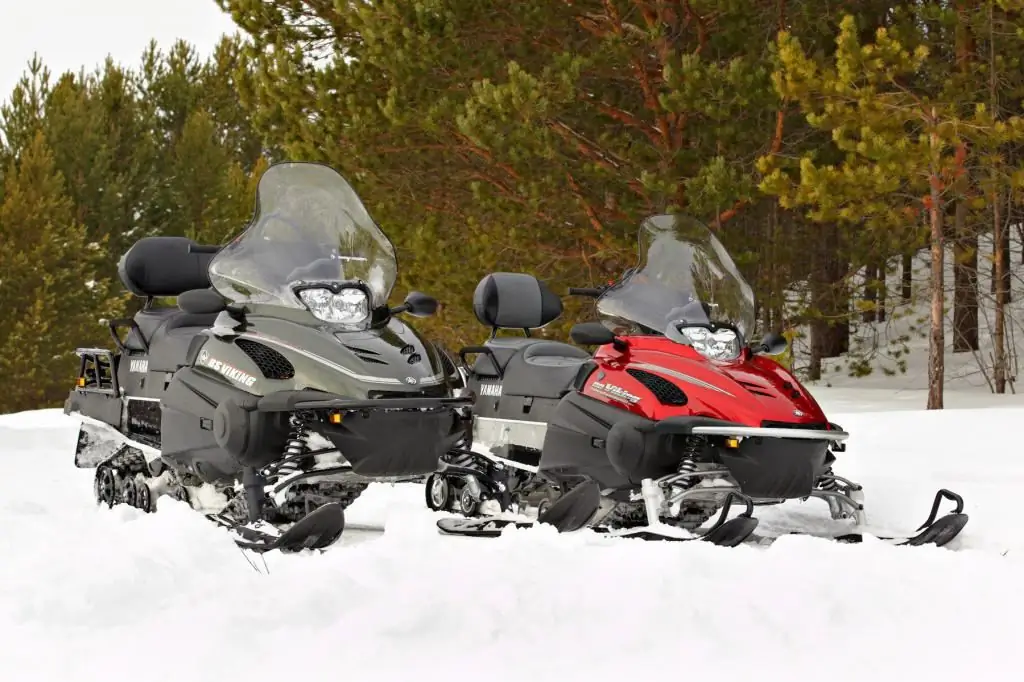2026 Author: Erin Ralphs | [email protected]. Last modified: 2025-01-22 21:14:14
Many of those who were born and raised in the Soviet Union probably remember small minibuses, and maybe minivans - RAF-977. This model has an interesting history, now there are practically none, and restored copies are in collectors' garages.
Kid from Riga
The creation of this minibus began in 1958 in Riga. The first car caused a lot of reproaches, and it had a very strange name - "Festival". All because they showed it to the entire automotive community just on the day of the Festival of Youth and Students in Moscow.
Unfortunately, the design had disadvantages and caused a lot of reproaches.

The body did not have the proper reliability, the database of components and assemblies by that time was already very outdated. Also, the front end did not look very stylish - the headlights were planted too close, and the chrome grille was made of horizontal bars that were too thin.
Based on Volga
At the same time, GAZ plants launched the production of GAZ-21. And now, in the summer they showed a new "Festival". Unlike its prototypes, where the body was notbearing, this model had a real frame, which the designers integrated into the power elements.

The capabilities of the units from the Volga barely covered the needs of a minibus, the gross weight of which was more than 2.5 tons. However, in those years, nothing alternative existed yet. But be that as it may, the government approved the production of RAF-977.
Start in series
The minibus production initiative received support in Latvia as well. Much has been done, and these efforts have not been in vain. The plant began to develop production, financial resources were allocated.
Before mass production, the bus was once again finalized, made a small restyling. Plus, they changed the name. It was no longer "Festival" - now it is RAF-977 "Latvia".
Exterior
The exterior was similar to the West German minivans from Borgward.

However, this is not plagiarism at all. Then, in the 60s, these were the majority of all cars that were produced. The design is modest but elegant. The designers who worked on it definitely had good taste. You can see what RAF-977 looked like. His photo is still preserved and presented in our article.
The appearance is particularly friendly. The design stood out with a cute “muzzle”. The front panel had a rather complex shape with a windshield tilted back. For this, new technologies were used, but the quality surprised everyone. It was high. This panel had practically no defects. AtThe window opening of the bodywork was quite rigid. People with experience will notice that different RAF-977 different modifications have different front panels. This can be easily explained. In the earlier model, where there are narrow windows, part of this very panel is made smooth, and the optics are moved forward a little.

Later model, the front end received a rectangular stamping and the headlights protruded less.
Optics
The headlights are small and the taillights are made of glass, not plastic. They are very similar to those that were installed on the ZIL-130 of the first years. A lamp was installed on the back to illuminate the license plate. Each model had its own flashlight.
At first, a special figured light from "Moskvich-402" was installed on the RAF-977 minibus. However, later, after improvements, the back was decorated with a semicircular original lantern. The handles and locks on the doors are from Moskvich 407-q, and later, in the early 70s, they began to use handles from the 408th. Then these parts were moved to RAF-2203.
Inside
Specialists, engineers, designers and designers who worked on the minivan tried their best to get the most spacious interior possible with the small size of the car.
The driver and front passenger could fit compactly on the left and right side. Between them was the engine.

This arrangement was considered a very advanced solution in the 50s and 60s. But there are drawbacks. So, the driver had to somehow fit intofairly limited space between the door and the hood. To make it a little more comfortable, the designers had to cut off the upper corner of the hood on the left.
The driver's seat was very different from those that are installed in modern cars. So, there were no adjustments at all. The pillow and back were very skinny. But unlike the seats on the UAZ-452, a normal, fully working mechanism was implemented there, which moved the seat back and forth. It was even more convenient to drive a RAF-977 car than in Loaf - the steering column here is short and not so high.
Dashboard
Instead of uncomfortable, ugly, primitive round cargo-type devices, the designers decided to use a more “passenger” panel from Moskvich. This combination was also produced in Riga. There was no glove box on the right, but under the panel there was quite a wide shelf where you could put small things.
Control comfort
The accelerator and brake pedal seemed to be "sandwiched" between the hood and the steering system. Everything is not so simple here - in order to be comfortable, the driver must have a certain size of his shoes.
All those who wear size 43-45 have difficulty pedaling. So, already with the 43rd size, when the accelerator is released, it hooks on the back of the brake pedal. This can be very, very dangerous. But there are no problems in sneakers or shoes in size 41.
When making a left turn, you can get caught on the door opening handles.

Herfor some reason they made it too close to the door. The gear selector is very comfortable and ergonomic. The lever is quite long and is located directly next to the steering wheel, right at hand. It turned out to be much more convenient than on subsequent models, where it was necessary to reach down to switch. As for the checkpoint operation scheme, it is no different from the GAZ-69.
Also, the driver can control the position of the radiator shutters - there is a special lever for this. This solution proved to be more reliable, unlike the cable drive in Moskvich or Volga.
Passenger seat
Very good is bad. Probably, this was what the designers and technical design specialists were guided by when they developed the passenger seat. The hood on the passenger side sticks out too much, and at a right angle.

On the right under the hood is a carburetor, as well as an air filter. The lid just couldn't shrink.
The space from the hood to the doors is less than on the driver's side. Everyone who sat in this chair stated that it was really very crowded. Getting into the cab is also not so easy - there is a wheel arch nearby. One of the specializations of the RAF-977 car is an ambulance. It must have been very difficult for women.
Natural ventilation
For some reason, the doors were made too thin, so much so that it was not possible to install power windows in them. The glass on the side did not fall, and only the window could be opened. There were two hatches in the ceiling to ventilate the cabin. To open them, a convenientlever.
The side windows were sliding and provided exhaust ventilation. As for the interior heater, it was located under the front passenger seat. The hoses with which the stove was connected to the cooling system were right under their feet. Many have tripped over them.
Passenger compartment
And here there is a lot of free space, and the floor is perfectly flat. The seats are made on an open frame. Seat cushions are thin.
There was an unexpectedly large trunk between the rear seats and the tailgate. There is much more space in the back of this mini-bus than in most other similar models. The space in the cabin was very important for the ambulance and a variety of laboratories. RAF-977-ambulance was very convenient in this regard.
Specifications
The body is made in the form of a van or minibus. Its structure is load-bearing, and it is made of steel. The ZMZ-21 engine was used as a power unit. Its working volume was 2.4 liters, power - 75 horsepower. The gearbox had only three forward speeds and a reverse one. The maximum possible speed was 115 km/h.
The front suspension is independent, the rear is dependent. The car was rear wheel drive. GAZ-21 was used as a platform. The length of the minibus was 4.9 m.
Exploitation: where and how
From the 60s to the 70s, the car was used in a wide variety of enterprises and public sector organizations. Then 977I, and later IM began to be delivered to ambulance sites. A little later on the basis of thismodifications released a car for transporting blood. Now you can purchase a reduced exact model - RAF-977 ambulance 1:43.
Besides, this minibus was widely used as a fixed-route taxi.

Model 977E was considered a tour bus. It was widely exploited by Intourist and other tourist organizations.
Export
At the end of the 60s, this minivan was successfully exported to countries such as Bulgaria, Hungary, Cuba and even Iran.
For export made modifications "Lux". The front part was equipped with a retractable roof, an open trunk was made in the back. In the interior, richer materials were used for decoration. In addition, the car had a walkie-talkie for tour guides.
Our days
But all this remained in the 70s. And today there are almost no RAFs. It is rare for any of the collectors to have a RAF-977 minibus in the garage. Tuning is a search for completely original spare parts and all other details. Also, the body is painted in original colors with good paint. The first photo shows an example of such a restored car. As you can see, even a bus forgotten at times can acquire a very attractive appearance. Of course, this car is not suitable for every day (GAZelles now perform its functions) - most often "for show".
So, we found out what the RAF-977 minibus has technical characteristics, interior and exterior.
Recommended:
"Yamaha Raptor 700": technical specifications, engine power, maximum speed, features of operation and care, reviews and owner reviews

Japanese company Yamaha, specializing in the development and production of motorcycles, is not limited to motorcycles and develops scooters, snowmobiles and ATVs. One of the best ATVs of the Japanese company is the all-terrain vehicle "Yamaha Raptor 700"
"Mercedes "Volchok"": specifications, tuning, reviews and photos

"Mercedes "Volchok"" is a car that is known throughout the world as the "five hundredth". Only by hearing the name alone, you can understand what this unit is. Mercedes w124 e500 - a car that in the nineties was an indicator of we alth and we alth
RAF-2203: owner reviews, specifications, photos

"Rafik 2203" is a favorite of many motorists, and even today it evokes nostalgic notes in their souls. And even now, when this model is no longer in production, this minibus remains a valuable rare copy for lovers of retro and antiquity
"Yamaha Viking Professional": technical specifications, engine power, maximum speed, operation and maintenance features, reviews and owner reviews

"Yamaha Viking Professional" - a real heavy snowmobile, designed to conquer mountain slopes and snowdrifts. From the curves of the front bumper to the roomy rear luggage compartment, the Yamaha Viking Professional literally speaks of its utility snowmobile
"UAZ-Pickup": specifications, price, equipment, tuning, reviews and photos

Serial production of this well-known throughout the CIS machine with a lot of advantages was launched in 2008

